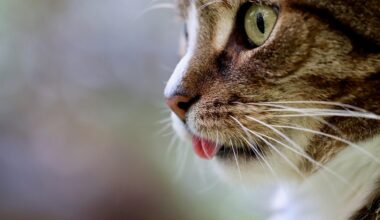The Role of Insulin Therapy in Managing Feline Diabetes
Feline diabetes mellitus is a significant metabolic disorder that impacts many cats, causing elevated blood glucose levels. Management of this condition is crucial to maintaining your cat’s health and quality of life. One of the most effective treatments currently available is insulin therapy, which assists in lowering blood glucose levels and allowing the cat’s body to use glucose more effectively. Feline diabetes is analogous to Type 2 diabetes in humans, where insulin resistance plays a vital role. Regular monitoring of blood glucose levels is essential to tailor the insulin dose to the individual needs of your cat. Insulin therapy can be a life-changing treatment, ensuring optimal health and vital energy levels in diabetic cats. The treatment requires a commitment from pet owners to follow a consistent schedule for insulin administration and feedings. This dedicated response in managing the condition can lead to successful outcomes. Understanding the specifics of insulin therapy is vital for pet owners managing diabetic cats, as it leads to informed decisions. Monitoring your cat’s response to treatment and maintaining routine vet check-ups will further enhance the management process.
There are several types of insulin available, and each acts differently. One of the most popular insulin types used in feline diabetes is NPH insulin, which is effective and relatively inexpensive. Another highly effective insulin is Lente, designed specifically for cats and offers longer-lasting effects. Insulin glargine, a long-acting insulin, is also gaining popularity due to its effectiveness in controlling blood glucose levels. The selection of insulin depends heavily on each cat’s specific condition and needs, which a veterinarian can help evaluate. The proper dosage and administration technique play a significant role in the success of treatment. Injection sites should be rotated to prevent potential lipodystrophy, ensuring that insulin is absorbed effectively. Owners are often encouraged to learn how to administer insulin injections, which may seem daunting. However, with practice and guidance from a vet, it becomes a straightforward process that can significantly improve the cat’s quality of life. Moreover, insulin therapy alone may not be sufficient. It must be paired with a proper diet and regular exercise to help maintain an optimal weight and blood glucose level.
Importance of Diet in Diabetes Management
A balanced diet is essential in managing feline diabetes alongside insulin therapy. The right nutrition can stabilize blood glucose levels, providing cats with energy while avoiding glucose spikes. It’s important to select a dietary regimen that’s low in carbohydrates while being rich in protein and fiber. High-protein, low-carb diets can imitate the natural feline diet and help regulate blood sugar levels. Additionally, feeding your cat several small meals a day can promote stable blood glucose levels, as opposed to larger, sporadic meals. Some veterinary prescribed diets are specially formulated for diabetic cats and yield great results. Consulting your veterinarian to find the best diet suited for your cat, in conjunction with insulin therapy, is a great strategy. Keeping your cat hydrated is also important, as it aids overall health. Regular monitoring can help you notice any changes in appetite or drinking habits, which can indicate glucose fluctuations. It’s essential to be vigilant regarding any signs of hypoglycemia, which can manifest as weakness, seizures, or confusion, necessitating immediate attention and adjustment of dietary habits.
Regular check-ups and blood glucose monitoring are critical components in managing feline diabetes effectively. Staying in touch with your veterinarian helps ensure that both the insulin therapy and dietary approaches are functioning optimally. Your vet might recommend regular blood tests to help gauge the effectiveness of insulin administration and dietary modifications. Home monitoring, using blood glucose meters designed for pets, can also provide insight into the cat’s glucose levels between vet visits. This can drastically enhance the understanding of how your cat is responding to treatment and help avoid emergencies. If blood glucose levels are running too high or too low, adjustments in insulin dosage or dietary changes can be made quickly. Moreover, a diabetes management plan should encompass situational responses, addressing how to deal with hypoglycemic states promptly. Owners should familiarize themselves with administering sugar or glucagon in emergencies, as this can save a cat’s life. Creating a management routine and effectively communicating with your vet can ensure your diabetic cat leads a healthier, happier life with a good quality of living.
Signs of Well-Controlled Diabetes
Monitoring the signs of well-managed diabetes is crucial for the health and longevity of your feline friend. Initially, upon starting insulin therapy, cats might display numerous symptoms such as excessive thirst, increased urination, and weight loss. However, as the treatment becomes effective, these symptoms should begin to diminish. A well-controlled diabetic cat will typically exhibit normal eating habits and may regain weight as their body begins utilizing glucose properly again. You may also notice a decrease in thirst and urination frequency. Cats tend to have more energy, in contrast to the lethargy they often experience when diabetes is uncontrolled. Regularly observing these signs will lead directly to understanding your cat’s response to their treatment. If any adverse symptoms appear or the expected progress stalls, immediate veterinary consultation is essential. Adjustments may be needed for insulin dosage, dietary changes, or additional interventions. Overall, being attentive to your cat’s daily behaviors and remarkable improvements will indicate that the management plan is effective. It offers substantial insights into their ongoing health and guides your care regime moving forward.
Information and education about diabetes are vital for cat owners newly navigating this often-daunting condition. Resources such as veterinary articles, online forums, and support groups can provide valuable insights and encouragement. Community support from fellow feline diabetes owners can alleviate feelings of isolation, sharing treatment experiences and suggestions. Engaging with others can help pet owners feel more empowered about managing their cat’s health. Furthermore, veterinarians often recommend specific resources that can guide you in proper insulin administration, dietary needs, and general care for diabetes. Keeping abreast of new research or advancements in treating feline diabetes provides additional context and possibly better treatment strategies. With a commitment to learning and staying informed, cat owners can more effectively manage the complexities of feline diabetes. It’s important to stay optimistic as many cat owners successfully manage this condition, allowing their pets to thrive despite the diagnosis. Your active involvement can lead to significant improvements in your cat’s quality of life, making the experience less daunting and ultimately rewarding.
Conclusion: Ensuring Quality of Life
In conclusion, the successful management of feline diabetes primarily hinges on insulin therapy, a balanced diet, and regular monitoring. With dedication and commitment, many cat owners successfully navigate the complexities of this disease. Insulin therapy has proven to be an effective strategy in reducing blood sugar levels, while dietary management can further support your cat’s overall well-being. Observing and learning your cat’s individual reactions to treatment can make a considerable difference in management effectiveness. Additionally, promoting regular veterinary check-ups and utilizing home monitoring can facilitate timely adjustments in treatment plans. Your attentive approach is crucial in recognizing both improvements and setbacks in managing diabetes. Tools, such as blood glucose meters and community knowledge resources, empower pet owners to optimize their cats’ care. Ensuring a positive quality of life for diabetic cats is achievable when a consistent care plan is followed. Maintaining open communication with your veterinarian and actively participating in the management of diabetes nurtures not only the health but also the happiness of your feline companion.


